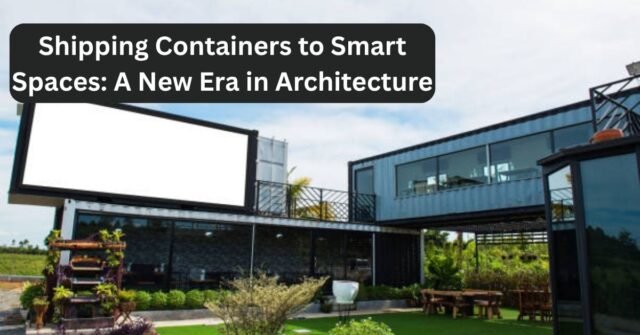Over the past two decades, architectural innovation has taken bold strides into unconventional terrain. One of the most revolutionary ideas has emerged from an unlikely source—shipping containers. Once used solely for transport and storage, these industrial metal boxes are now central to a modular transformation in design, redefining the future of commercial, residential, and institutional spaces.
From portable offices to eco-conscious homes and commercial establishments, container-based architecture is becoming the face of efficiency, sustainability, and adaptability. In global hubs and emerging cities alike, modified container structures reflect a smart, scalable solution to the challenges of modern infrastructure.
The Rise of Container Architecture
Shipping container architecture, often referred to as cargotecture, was once considered a fringe concept. It is now being adopted by architects and developers seeking flexibility and sustainability in both urban and rural environments. The appeal lies in its adaptability—containers can be transformed into single units or connected to form multi-level buildings.
The architectural potential of a shipping container lies not only in its form but also in its function. They offer a pre-fabricated, stackable, and mobile structure that simplifies construction logistics and reduces lead times drastically.
Modular Design: A Flexible Approach to Modern Construction
One of the major appeals of container construction is its modular nature. The dimensions of standard containers make them ideal for scaling up or down depending on project needs. This flexibility makes them a popular choice for temporary installations, site offices, mobile clinics, pop-up shops, and even permanent homes.
Many modern shipping container office space setups take advantage of this adaptability. Businesses looking to expand quickly without navigating the complexities of traditional construction often opt for modular office solutions. These units can be deployed rapidly, relocated easily, and customized to match evolving workspace needs.
Container Modification: Innovation Beyond the Box
What transforms a shipping container from an industrial shell into a functional space is skilled modification. In locations like Dubai and other fast-growing urban landscapes, container modification has become a booming segment within the construction sector. This transformation includes structural reinforcements, thermal insulation, plumbing, HVAC integration, and even aesthetic customization.
Especially in hot desert climates, container units must be modified to ensure energy efficiency and thermal performance. High-performance insulation materials, reflective coatings, and climate-control systems are commonly integrated during the retrofitting process. As a result, modified containers can achieve energy ratings comparable to or exceeding traditional buildings.
Benefits of Shipping Container Spaces
The widespread use of container spaces isn’t just a design trend—it’s backed by a host of practical advantages that make them a preferred choice for modern construction.
1. Rapid Deployment
Container structures can be assembled and installed in a fraction of the time it takes for traditional builds. Since much of the modification is done off-site, on-site installation is swift and minimally disruptive.
2. Sustainability
Reusing decommissioned containers for architecture reduces construction waste and supports eco-friendly design practices. With growing emphasis on green buildings, container-based structures align well with sustainability goals.
3. Cost Efficiency
In many cases, building with modified containers is more affordable than conventional methods. Costs related to materials, labor, and time are significantly reduced.
4. Portability
One of the standout features of these spaces is their mobility. Whether used as a shipping container office space, medical unit, or retail kiosk, the structure can be relocated based on business needs or environmental conditions.
Commercial Applications Across Industries
Shipping container spaces are not limited to residential use. Across industries, they’re gaining popularity for their versatility and branding potential.
- Corporate Offices: Businesses are increasingly turning to containers for office expansion, especially in remote or underdeveloped regions.
- Hospitality & Retail: Pop-up cafes, food trucks, boutique shops, and even container hotels are becoming common in cities around the world.
- Construction & Site Work: Containers are regularly used as project management offices, changing rooms, or storage on construction sites due to their durability and security.
In Dubai, for instance, container modification techniques are used extensively to meet commercial building codes and design preferences without compromising on speed or efficiency.
Architectural Trends in Container Design
Modern designers are constantly innovating ways to make container spaces more functional and appealing. Some of the most notable trends include:
– Multi-Unit Stacking
By combining multiple containers vertically or horizontally, architects create multi-room offices or apartment-like complexes. Structural engineering plays a critical role here, ensuring load distribution and stability.
– Biophilic Integration
Adding natural elements such as vertical gardens, skylights, and open courtyards within container designs helps promote wellness and reduce the industrial look often associated with metal boxes.
– Smart Automation
Technologies such as IoT-based lighting, security systems, and energy monitors are often built into container units, making them future-ready smart spaces.
Challenges and Considerations
While shipping container spaces offer numerous advantages, they also come with challenges that must be addressed during the design and construction phases.
- Insulation & Ventilation: Containers are not naturally suited for hot climates. Proper insulation, ventilation, and shading must be incorporated, especially in areas like Dubai where container modification standards are stringent.
- Structural Integrity: Modifying the steel structure requires careful engineering to ensure doors, windows, and other cut-outs don’t compromise the container’s integrity.
- Permits and Zoning: Though easier to deploy, container structures may still face regulatory hurdles depending on the location and purpose of use.
Despite these challenges, modern solutions and engineering practices have made container-based construction more feasible and compliant with local building codes.
The Future of Smart Spaces
As more cities adopt sustainable development goals and seek faster ways to house growing populations, shipping container architecture is likely to expand its footprint. It’s already being explored as a solution for:
- Affordable housing in high-demand urban areas
- Emergency shelters in disaster-prone zones
- Temporary classrooms for educational institutions
- Remote field offices for industries like mining and agriculture
Shipping container office space units, in particular, are set to revolutionize the concept of dynamic work environments—offering businesses a blend of mobility, efficiency, and contemporary design.
Final Thoughts
The transformation of shipping containers into smart architectural spaces signals a new era in design and functionality. More than just a passing trend, container-based architecture represents a shift toward efficiency, eco-awareness, and flexibility.
Whether it’s through expertly crafted container modification Dubai or the expansion of modular offices across the globe, these steel giants are no longer limited to transport. They are the building blocks of tomorrow’s architecture—resilient, adaptable, and undeniably smart.







